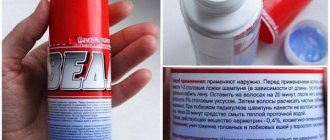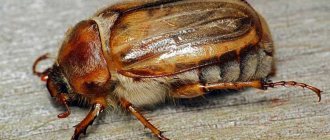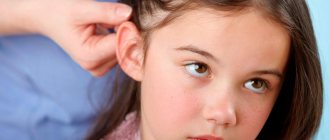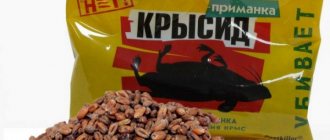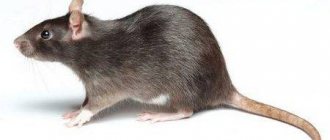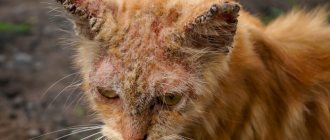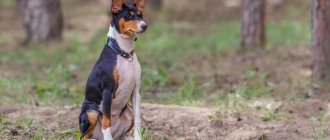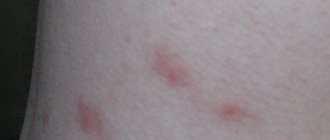If you notice small whitish grains in the hair on your head, you can mistake them for dandruff. However, not only peeling of the epidermis, but also pediculosis looks similar.
With a careful examination, it will be possible to accurately determine the disease and only after that it is necessary to begin treatment.
Dandruff concept
In medicine, the term dandruff refers to increased exfoliation of particles of the scalp. The pathology can persist for a long period of time and is provoked by improper functioning of the sebaceous glands, as a result of which the processes of exfoliation of the keratinized upper layer of skin are disrupted.
Scales of different shapes cover the hair along its entire length; there are more of them in the upper part of the head. White particles are especially noticeable on dark-colored hair; dandruff itself is not contagious (provided that it did not arise due to the proliferation of pathogenic bacteria and microbes).
Dandruff
A number of dermatological diseases are also accompanied by this symptom and can be transmitted through exfoliated particles of the scalp.
Important! In dry skin, flaking occurs due to a lack of natural oils and is accompanied by symptoms such as tightness, itching, split ends and dry hair.
Oily skin, on the contrary, suffers due to increased sebum secretion and the proliferation of microorganisms, resulting in dandruff, hair quickly becomes greasy after washing, looks unkempt and sticky.
Useful tips
Since lice and dandruff are somewhat similar, it is recommended to consult a dermatologist to determine the existing disease. Treatments for head lice and increased skin exfoliation vary.
In the first case, the use of antiparasitic agents, which include insecticides, is required.
The second requires skin hydration and nutrition. If there is a dermatological disease, for example, seborrhea, the use of appropriate medications is required.
The recommendation is the same for both cases: if white scales are detected, you should immediately contact a specialist.
Who are these nits?
Trichologists call lice eggs nits - white capsules within which larvae develop. It is difficult to remove them manually: due to a special adhesive substance, the shells are firmly attached to the hairs.
Experts note their high survivability. After the parasites are removed, the capsules often remain on the head and after some time new individuals emerge from them. Therefore, for treatment it is necessary to use effective, strong agents that can destroy not only adult insects, but also their larvae in shells.
The following signs allow you to understand whether a person is infected with lice:
- a feeling of strong, unbearable itching;
- hair that gets dirty quickly;
- the presence of small white grains on hair curls.
Adult lice actively feed on blood and reproduce. And in one superficial examination of the head, it is sometimes possible to detect up to a hundred nits.
Important! Lice are not just a cosmetic problem; they cause serious discomfort to their victims and cause the development of certain infectious diseases.
Why does dandruff appear after treatment for pediculosis?
If dandruff appears after removing lice, you should hardly be surprised, since treatment methods in this case are quite aggressive and can negatively affect the skin. Control methods can be mechanical or chemical. In the first case, it is proposed to wash the hair in very hot water - the temperature should be on the verge of tolerance - using tar soap or shampoo. Then blow with a hairdryer using the hottest air possible for half an hour. After this treatment, combing out parasites and their eggs is much more effective.
This is interesting: How to distinguish dry dandruff from oily dandruff: signs of each type, characteristic manifestations, mixed form
Also, as a mechanical method, you can use special combs and comb twice a day. Previously, special combs only helped against parasites and had no effect on nits. However, there are now laser-cut combs that kill eggs.
Before buying chemical reagents, it is advisable to consult a doctor, since such products are quite toxic, which is especially dangerous in the presence of allergic reactions. The most commonly used drugs are Para-plus, Medifox or Nittifor. However, even gentle products can have a negative impact on the condition of the skin. As you can see, all three methods can cause damage and irritation to the scalp. Therefore, the appearance of dandruff after treatment for pediculosis is a fairly common occurrence.
Differences
With proper lighting during examination, it is not difficult to distinguish dandruff from nits. It is advisable to take a lamp, direct the light to the desired area, arm yourself with a magnifying glass, a comb with fine teeth and find 30 minutes of free time. So, how can you tell the difference between lice and dandruff? There are several ways.
Nits
By location
Female parasites choose warm areas to lay nits on human hair. Insects leave eggs at a distance of 1-3 cm from the hair roots. Most often, the back of the head, forehead, temples and behind the ears are affected, while dandruff is located throughout the head.
To size
Another difference is that nits look like small white oval balls, sometimes they have a light gray or brown tint, while dandruff is more of a white color.
Exfoliated skin flakes are different in size, they can be both small and large, unlike nits - they are almost the same.
By itch
This symptom is accompanied by both diseases, but the main difference between nits and dandruff is how severe the itching is. The saliva of lice contains a special secret: when it enters the victim’s body during a bite, the secret provokes a reaction in him, expressed in the form of itching.
The desire to scratch the head can be so strong that an infected person scratches the epidermis almost until it bleeds. The more bites, the stronger the itching, and it can spread throughout the entire skin.
By sound
You will be able to distinguish nits from dandruff by sound: you just need to gently press on the egg and a characteristic click will appear.
If a developing embryo lives inside the nit, this can be easily determined by its voluminous rather than hollow shell.
By combing
Dandruff can be easily combed out with a regular comb, but getting rid of larvae in eggs is definitely not possible. To distinguish nits from dandruff, just shake your head, comb your hair, or run your hand through your hair, and then a lot of small light particles will remain on your shoulders. During these manipulations, the nits will remain glued to the hair.
Combing
In count
There is always a lot of dandruff, while parasite eggs appear in relatively small quantities. The exception is a severe infestation of lice, in which case you can find significantly more capsules on the head, and you will have to determine whether it is lice or dandruff by other signs.
How to distinguish tubular dandruff from nits
From afar, dandruff, especially tubular dandruff, quite closely resembles lice eggs.
There are several simple, but very effective methods, thanks to which you can easily and without a doubt distinguish the manifestations of seborrhea from pediculosis:
- Hair lag . Dandruff can be easily removed from hair by simply running a brush through it several times. Nits are a different matter; they are firmly attached to the hair with a special substance that the louse secretes; it is impossible to remove them with regular combing.
- Appearance . Dandruff resembles nits only upon superficial examination. In fact, the eggs are oval in shape, their color ranges from light gray to dark brown. Dandruff looks more whitish against this background. The difference is also observed in size - while exfoliated skin particles in one area can be large and small, then the parasite eggs look almost identical in size.
- Location . Skin flakes can be scattered over all parts of the head, but the louse attaches its eggs in warmer areas, choosing mainly either the back of the head or areas behind the ears.
- Itching is inherent in both pathologies , but in the case of pediculosis it is more intolerable and unpleasant. Parasite bites force the victim to scratch the skin almost until it bleeds
Another characteristic feature of a living nit is the loud clicking sound it makes when crushed between the nails. The shell of the egg, from which the parasite has already hatched, does not make any sounds when pressed.
How can you tell whether a parasite has hatched from an egg or not?
The presence or absence of an insect embryo in the egg will be indicated by:
- flat shape (the inanimate capsule loses its original appearance);
- no cracking sound when you press the shell;
- a living cocoon is shiny, a dead one is dull in color;
- when the lice leave the cocoon, the color changes - the capsule ceases to be white and becomes cloudy with a yellowish tint.
For reference! Special combs sold in pharmacies help remove nits from hair. A comb alone is not enough to completely get rid of lice and nits.
Causes of diseases
The presence of dandruff in humans is a very common phenomenon. This is due to many factors:
- incorrectly selected shampoo;
- dry and irritated scalp;
- lack of vitamins and microelements;
- bad ecology;
- improper lifestyle, nutrition, daily routine;
- stressful condition.
You can only become infected with lice from another parasite carrier. Lice most often appear in children. The main sources where parasites come from can be:
- close contact with a patient in public transport, a bathhouse, or a cramped room;
- use of the patient’s personal items: comb, towel, bed linen, clothing, hats;
- use of non-sterile items in the hairdressing salon.
Once the disease is identified, nits or dandruff must be treated.
Signs of lice
From a young age, children are taught to be clean and hygienic. For these purposes, special programs and instructions have been developed.
Detergents and disinfectants are produced specifically for the prevention of head lice. However, despite all the measures, outbreaks of pediculosis (lice) occur in the most unexpected situations.
When a person’s scalp begins to itch, they need to conduct a thorough examination of their hair as soon as possible. As a rule, unpleasant sensations are accompanied by intense formation of dandruff.
Practice shows that with a superficial examination one may not be able to distinguish nits from dandruff.
Active work aimed at promoting a healthy lifestyle has brought positive results.
The vast majority of the population lives in conditions that meet all sanitary standards.
People know well how to get rid of dandruff and speed up hair growth. At the same time, the appearance of lice and nits comes as an unpleasant surprise to many.
According to scientific sources, more than one and a half hundred species of this insect live in nature, which have certain differences.
The following species pose the greatest danger to humans:
- head louse;
- cootie;
- pubic louse.
These species have to be distinguished from one another. Lice, and then nits, can attach themselves to a person completely unnoticed.
Each type of lice has its own habitat on the human body and can cause serious harm to the body.
The life cycle of an insect consists of feeding on human blood and laying nits for reproduction. Dandruff is formed as a by-product of the life of the head louse.
The body louse is often found in the folds of clothing and jumps onto the body to feed. The pubic louse lives in the perineum.
Outwardly, they differ little and these differences do not alleviate the condition of a person who suffers from bites.
It is very important to get rid of their presence as quickly as possible, using all available methods.
This is interesting: Causes of dandruff on the head in women: what causes it and why, how to fight it, how to get rid of seborrhea on the scalp
By type, the louse is a parasite that feeds on the blood of mammals. According to experts, this parasite sucks blood from human skin three times a day.
Essentially, an open small wound forms on the head and begins to itch. The photo clearly shows the structure of the insect.
It has a sharp sting for opening the skin and a voluminous abdomen for digesting sucked blood. This miniature monster hatches from a nit.
At first glance, it is not so easy to distinguish a nit from a flake of dandruff. External similarity often misleads people, and the appropriate course of treatment is prescribed with a delay.
